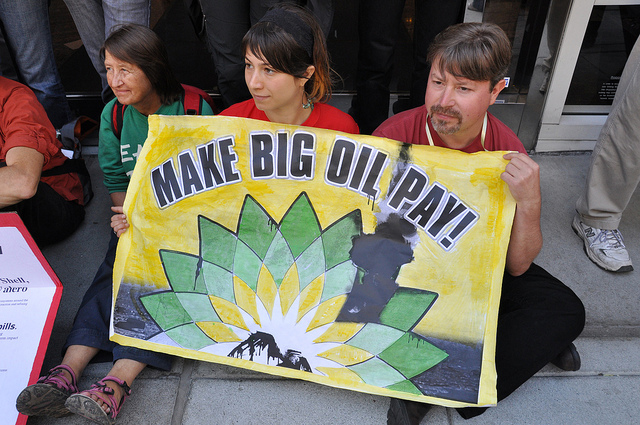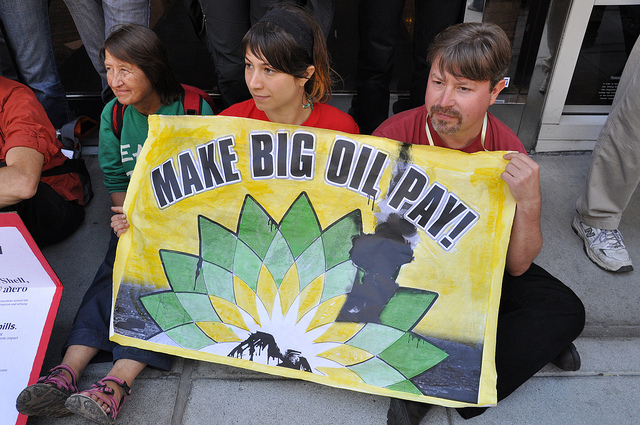
 The recent sudden collapse (and predicted permanence) of oil’s stock prices on the heels of the coal market collapse seems to have been a far greater convincer to divest, sad to say, than the recent collapse of the vast Western Arctic’s ice sheet, and other significant polar and glacier meltdowns around the globe. (Photo: Rainforest Action Network)
The recent sudden collapse (and predicted permanence) of oil’s stock prices on the heels of the coal market collapse seems to have been a far greater convincer to divest, sad to say, than the recent collapse of the vast Western Arctic’s ice sheet, and other significant polar and glacier meltdowns around the globe. (Photo: Rainforest Action Network)
The oil market’s crash involves billions in fossil fuel holdings in institutional and pension portfolios, providing divestment campaigners a golden opportunity to point out that “fiduciary responsibilities” would seem to call for immediately cutting their losses.
On global Divestment Day (February 13), the sponsoring group 350.org will announce increasing success in convincing investment officials of the nation’s largest funding sources – pensions, foundations, faith-based and public institutions, governments – to drop holdings in fossil-fuel companies and their vital vendors.
Those entities have been tagged as the chief source of the greenhouse gas emissions extinguishing all life on our planet for today’s short-term profits.
The recent sudden collapse (and predicted permanence) of oil’s stock prices on the heels of the coal market collapse seems to have been a far greater convincer to divest, sad to say, than the recent collapse of the vast Western Arctic’s ice sheet, and other significant polar and glacier meltdowns around the globe. These release methane gases more lethal to the atmosphere than carbon dioxide (CO2).
Even back in 2007, the Environmental Protection Agency (EPA) warned that the “largest single source of global greenhouse gas emissions” was fossil-fuel extraction and its use for energy: CO2, 57 percent; and methane, 14 percent. Those figures are dwarfed today.
Add to an oncoming Armageddon the drying up of water supplies and desertification in California and elsewhere on one hand and, on the other, the unstoppable rising of oceans and seas lapping at coastal cities and islands like the Carolinas’ Outer Banks and the Maldives. Their destiny is to become like Atlantis, the legendary underwater empire.
The global 350 divestment campaign aims to ward off, or at least mitigate, this catastrophe by convincing fossil-fuel stockholders of these gigantic polluters to sell all their holdings in stocks and bonds. “Divest-and-Reinvest” has been the message they’ve carried these past two years into boardrooms of foundations and public entities with interest or earnings on reserves or endowments – sometimes millions – chained to the fossil fuel industry, including its vendors and financial backers.
Thus far, campaigners have focused presentations on the morality of saving the environment. Or preventing the extinction of all life. Or social justice needs. Or the merits of renewables, especially wind and solar. Or on stigmatizing holdings from London’s Carbon Tracker Initiatives’ infamous list of 200 major fossil fuel companies owning most of the world’s coal, oil and gas reserves.
The latest major strategy is political, lobbying governmental officials to divest public holdings for all of the above reasons – or lose the next election because of outraged voters. Savvy campaigners do their homework on trustees and politicians to apply the right strokes.
And they’ve had considerable and growing successes – big ones in the last few months. Investment boards and officers at a trio of major institutions joined 181 other entities and 650 wealthy stockholders in divesting more than $50,000,000,000 from fossil fuel holdings: Stanford University, the multibillion-dollar Rockefeller Brothers Foundation, and, just days ago, Maine’s public university system.
Campaigners have had heavy backup from environmental organizations, stockholder groups and investment monitors, but also – inadvertently – from the industry’s bubbles and bullying.
One group of heavy hitters has been the 70-member CERES nonprofit, whose members manage more than $3,000,000,000,000 in assets.
Another has been the Carbon Tracker Initiative, with its trenchant, research-heavy, highly credible constantly updated reports. They have kept warning stockholders about coming supply-gluts of fossil fuels that could never be burned. Stockholders would be left facing “stranded assets.”
CERES contacted 45 major companies demanding to know their future production plans, particularly capital expenditures (“capex”). Few responded and others answered mostly in vague terms.
CTI’s researchers went to work to provide near-future statistics, based on company data. They found spiraling, out-of-control exploration/production costs – particularly for fracking – slashing future profits and stockholder earnings. Having to drill several dry holes to get a “wet” one involved stratospheric costs. Huffington Post pegged them currently at $3,000,000 to $11,000,000 per “wet”- none of which has an unlimited production horizon.
CTI’s 2014 report said the break-even price between cost and profits had risen to $80 per barrel. In January, it was $95, even as that predicted supply glut forced sales to a disastrous $45 per barrel, according to CTI chief executive officer Anthony Hobley in a mid-January BusinessGreen article. He indicated that a turnaround was unlikely in the near future. My gas station posted an eye-popping $2.09 per gallon price January 30, reflected around the country, indicating supply far exceeded US consumer demand.
Fossil-Fuel Industry’s Increasing Flurry of Cancelled Projects
The crash also was reflected in the corresponding almost daily flurry of cancellations and deferrals by industry giants (Chevron, Shell, Statoil, etc.) for new exploration/ production projects in the Arctic, Canada’s tar sands, and deepwater areas. Mergers began: first, among service vendors such as Halliburton acquiring Baker Hughes. Hobley’s most recent advice to stockholders should shake the 350’s campaign’s target audiences awake. He pulled no punches:
[The fossil-fuel crisis] is also driving a new urgency amongst major oil investors to review their exposure to assets that are destroying shareholder value and putting pressure on asset managers to shelve capex [capital expenditures], diversify portfolios and invest in cost-effective low carbon energy. The message is being heard loud and clear amongst some big pension funds. They are questioning development strategies, and in some cases curtailing investments. . . . Moreover, increasing constraints on emissions through growing regional climate laws, energy efficiency gains, improvements in technology, not to mention the slowdown in the Chinese economy, will only impact oil demand and prices further, speeding up the drive towards cleaner energy sources.
Now, many campaigners might shrink from focusing a presentation on the very issue that could galvanize audiences to divest from fossil fuels. They may hesitate to distribute copies of Hobley’s blunt article or charts of the industry’s astonishing and, seemingly permanent, nosedive in profits and earnings. After all, they’ve suffered turndowns galore when trustee chairs or investment directors listen politely to their compelling points, but then brush them aside with a curt or kind “not-interested” response rooted solely on the priority of profits before the planet. Only it’s usually couched in terms of their “fiduciary responsibilities” to an entity.
Squeamish or not, savvy campaigners will speak an uncomfortable truth to power about putting profits before saving the planet for future generations. And the bottom-line for those audiences – states, municipalities, billion-dollar foundations and pension funds, public or private institutions – is still fiduciary responsibility. Portfolios may have a few thousand dollars in green holdings to demonstrate concern for Mother Earth’s sustainability, but these audiences are unlikely to divest from the industry unless those investments are replaced by equal or better holdings.
In City of Portland (OR): It’s Profits, Not Saving the Planet
For example, my investigation of Portland’s holdings – amid the mayor’s hedge that none were directly in fossil fuels – revealed that 49 percent of $80,380,000 in corporate bonds were issued by that industry. Then in June, at an initial meeting of the city’s temporary “socially responsible investment advisory” committee, the city treasurer even boasted about Exxon seeking – and getting – a mid-term note (bond) for $20,350,000. The shock to me was that none of those “socially responsible” members objected to lending taxpayer millions to the perpetrator of the Valdez environmental disaster. Or demanded to know why a company worth $486,429,000,000 would need a $20 million loan from Portland.
Worse was recently discovering that billions of Oregon’s public pension funds were heavily dependent on earnings from dozens of industry holdings. At least 25 were on CTI’s list of 200: Foreign companies included BHP Billiton, BP, CNOOC, ENI, Gazprom, Shell, Statoil, and Total; US firms included Anadarko, Arch Coal, Chevron, Cloud Peak, Conoco, Phillips, Exxon, Hess, Husky, Marathon, Noble, Occidental and Peabody.
Perhaps to head off visits by my 350 divestment colleagues, the state treasurer laid out the sole and curious reason for rejecting divestment, in a June Oregonian op-ed.
In divesting, he said: “There is no guarantee that . . . new owners will be advocates for either responsible management strategies or for reduced carbon emissions.” Moreover, divestment has no effect on targeted companies and does “not change corporate behavior.” To strengthen this specious defense, the state’s Investment Council chair declared:
“Our job isn’t to make the world better. We can’t look at social issues in making decisions. The general objective for investments is to make the moneys as productive as possible.”
Undoubtedly, the same situation exists for many states’ public pensions. In North Carolina, for instance, the Pando website reported Wall Street dealmakers demanding secrecy about exorbitant fees for managing high-risk pension investments. They got legislators to prepare a bill preventing public scrutiny of transactions for at least a decade, long after the statute-of-limitations had expired.
True, treasurers may concede pensioners or taxpayers have a right to know where their monies are invested. They may even run a holdings list on a website page, but it tends to be a summary of the top 10 or 20. Not the bottom 250. Charging people per page for downloading public records is another common device preventing public transparency and, where investment holdings are concerned, facing any questions about investment.
Open-Record Transparency Challenges Student Activists
Thus, if ordinary citizens face red tape and expense for access, consider the difficulties student divestment teams have encountered at public universities. At Portland State University, the state’s largest institution, officials have barred student divestment campaigners from access to holdings’ information. They have been regarded as uppity children instead of major contributors to the school’s financial survival – and generational victims of climate change’s increasing disasters. Most administrations count on students not having the money, time, energy – or standing – to pursue a lawsuit for records or challenge to investment policies.
The challenge is even greater at private institutions with millions in endowments. Such has been the case of recent divestment turndowns at Harvard University in the East, and its far smaller counterpart Reed College on the West Coast, despite long and brilliant campaigning by students and faculty.
Fossil Free Reed’s team knew they could not access their school’s investment records, but were even denied their request to furnish an expert on sustainable investments for presentations at trustee meetings. Their divestment petition was rejected on grounds that trustees’ principal responsibility and objective for its $518,000,000 endowment investments was, as usual, fiduciary responsibility
The Divest Harvard team at least knew the university had nearly $34,000,000,000 in endowments, regularly fattened by $11,800,000 in industry holdings. But as its president intoned, divestment was neither “warranted or wise” and retaining holdings would give the university greater influence on the companies; the trustees not only voted against divestment, but increased investments in those holdings by an astronomical $67,700,000.
These dismaying turndowns are not singular in this campaign. They provide invaluable and immediate lessons on overcoming objections based solely on profits.
Considering the oil market’s crash undoubtedly involves billions in fossil-fuel holdings in these institutional and pension portfolios, 350 divestment campaigners have a golden opportunity in their presentations to point out that “fiduciary responsibilities” would seem to call for immediately “cutting their losses.” What could be a greater satisfaction than executing “fiduciary responsibilities” and saving Planet Earth?